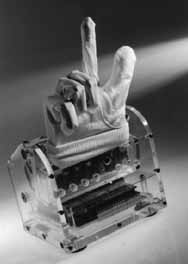Assistive Technology Projects - Development of PrototypesJames Anderson, JEM; David A. Brown, PhD, PT; Charles G. Burgar, MD; Deane Denney; Arden Farey; Vincent R. Hentz, MD; David L. Jaffe, MS; Deborah Kenney, MS, OTR; Maurice LeBlanc, MS; Stephanie O'Leary, MS, OTR; Eric E. Sabelman, PhD; Alvin Sacks, PhD; Douglas Schwandt, MS; Jaime S. Vargas, MS; Peter Werner, MD; Conal B. Wilmot, MD Ultrasonic Head Control Interface Jaffe The Ultrasonic Head Control Unit is an interface serving people without control of their arms or legs. The user's head position is calculated from ranging data provided by two Polaroid ultrasonic transducers. The head position information is then used for the realtime control of an electric wheelchair or a computer's mouse. Tilts of the user's head off the vertical axis (forward-backward, left-right) operate the wheelchair or move the screen cursor. The primary advantage of this device is that it requires no mechanical contact between the transducers and the user's head. The user, therefore, does not feel "wired up". The interface is intuitive to use, unobtrusive, cosmetically pleasing, and socially acceptable. Within the VA, the Technology Transfer Section in Baltimore has completed a nationwide clinical study of commercial prototype wheelchairs equipped with the interface (from Eureka Labs in Sacramento) and is now funding a cooperative effort with the Cerebral Palsy Research Foundation of Kansas to move this technology to the marketplace. Jaffe, Schwandt, Anderson
|
